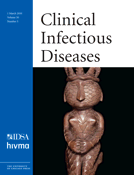Distribution of airborne influenza virus and respiratory syncytial virus in an urgent care medical clinic
Auteur William G Lindsley
Auteur Francoise M Blachere
Auteur Kristina A Davis
Auteur Terri A Pearce
Auteur Melanie A Fisher
Auteur Rashida Khakoo
Auteur Stephen M Davis
Auteur Mark E Rogers
Auteur Robert E Thewlis
Auteur Jose A Posada
Auteur John B Redrow
Auteur Ismail B Celik
Auteur Bean T Chen
Auteur Donald H Beezhold
Résumé BACKGROUND: Considerable controversy exists with regard to whether influenza virus and respiratory syncytial virus (RSV) are spread by the inhalation of infectious airborne particles and about the importance of this route, compared with droplet or contact transmission. METHODS: Airborne particles were collected in an urgent care clinic with use of stationary and personal aerosol samplers. The amounts of airborne influenza A, influenza B, and RSV RNA were determined using real-time quantitative polymerase chain reaction. Health care workers and patients participating in the study were tested for influenza. RESULTS: Seventeen percent of the stationary samplers contained influenza A RNA, 1% contained influenza B RNA, and 32% contained RSV RNA. Nineteen percent of the personal samplers contained influenza A RNA, none contained influenza B RNA, and 38% contained RSV RNA. The number of samplers containing influenza RNA correlated well with the number and location of patients with influenza (r= 0.77). Forty-two percent of the influenza A RNA was in particles < or = 4.1 microm in aerodynamic diameter, and 9% of the RSV RNA was in particles < or = 4.1 microm. CONCLUSIONS: Airborne particles containing influenza and RSV RNA were detected throughout a health care facility. The particles were small enough to remain airborne for an extended time and to be inhaled deeply into the respiratory tract. These results support the possibility that influenza and RSV can be transmitted by the airborne route and suggest that further investigation of the potential of these particles to transmit infection is warranted.
Publication Clinical Infectious Diseases: An Official Publication of the Infectious Diseases Society of America
Volume 50
Numéro 5
Pages 693-698
Date Mar 1, 2010
Chercher cette référence sur : Google Scholar, Worldcat
doi:10.1086/650457
Laisser une réponse
Vous devez etre connectez Pour poster un commentaire










